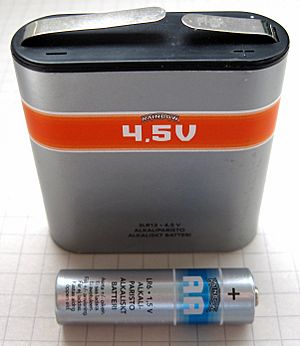Direct current facts for kids
Direct current (often called DC) is a type of electric current where electricity flows in only one direction. Think of it like water flowing in a river – always moving forward, not back and forth. This is different from alternating current (AC), where the electricity changes direction many times a second.
DC electricity always moves from the positive side (or "pole") of a power source to the negative side. Long ago, people called it "Galvanic current."
Contents
Where Does DC Come From?
Many everyday things use or produce direct current.
Common Sources of DC
- Batteries: These are probably the most common source of DC. The batteries in your remote control, phone, or flashlight all provide direct current.
- Solar Panels: When sunlight hits a solar panel, it creates direct current.
- Power Supplies: Many electronic devices, like your computer or game console, plug into a wall outlet (which provides AC). Inside their power adapter, there's a special part called a rectifier that changes the AC from the wall into DC that the device can use.
How DC Travels
Direct current usually travels through materials that conduct electricity well, like copper wires. It can also travel through empty space, like in the electron beams that were used in old TV screens.
The History of DC
Direct current was very important in the early days of electricity.
Edison's Early Power Systems
In the late 19th century, a famous inventor named Thomas Edison built the first systems to deliver electricity to homes and businesses. These systems used direct current.
Why AC Became More Popular
Today, most of the electricity delivered to our homes is alternating current. This is because AC is easier to send over long distances using transformers. However, direct current is still used for sending electricity to very far-off places, especially with something called High-voltage direct current.
Converting AC to DC
If a device needs direct current but gets alternating current from the power grid, the AC is first sent to a special station. There, it's changed into DC before it's used.
How We Understand DC Flow
When electricity was first studied, scientists thought that positive charges were moving. So, they decided that current flows from positive to negative.
Electrons and Conventional Flow
Later, physicists discovered that electricity is actually carried by tiny negative particles called electrons. These electrons actually move from the negative side to the positive side. However, the original idea of current flowing from positive to negative was already widely used, so it became the "conventional" way to describe current flow, and we still use it today.
Related pages
Images for kids
See also
 In Spanish: Corriente continua para niños
In Spanish: Corriente continua para niños


